08-20-2020, 07:44 AM
Been a while since I updated this project, I've been doing bits and pieces on it as other things permit. I got the fixed end of the curl rams done a few weeks ago, the rams I bought have a clevis arrangement at both ends so I'm working around that. Made some bushes from 4140 and sandwiched them between plates of 10mm mild steel, then cooked and quenched to case harden the bushes before mounting them to the arms.

Having the curl rams in place allowed me to start figuring out the parallel linkage arrangement, lots of plywood mockups and eventually I decided I need to be able to lift the loader to full height to ensure the angles allow it to empty a bucket at full height. The idea of the parallel linkage is to increase the total rotation, the old single linkage only rotated the bucket through about 160 degrees or so, which meant it was not curled back enough to keep stuff in when down low, and would not empty dirt without a vigorous shake when up high. It will now rotate through about 210 degrees, so curls fully back at ground level and tips almost upside down at full height. Anyway I needed to get the new 3-spool valve mounted and get the hydraulic hoses fitted up so I can lift and curl to confirm everything before I start cutting steel for the linkages.
I temporarily mounted the loader back onto the tractor to ensure I got the new control valve mounted in a nice ergonomic position- will get a photo of that- then I got a mobile hydraulic hose guy out to make up all the hoses. His portable crimping machine was a nice bit of kit. His invoice was just over double what I expected

I got prices for all the hose brackets that I need to keep everything tidy, was planning to use the usual poly block type gizmos but after spending up on the hoses I thought I'd save some cash and make my own brackets in aluminium.
I sacrificed another old mag wheel and cast some bar stock

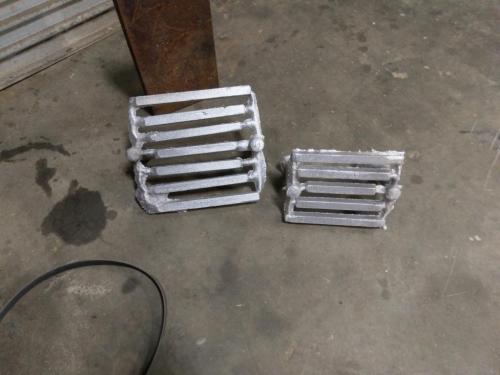
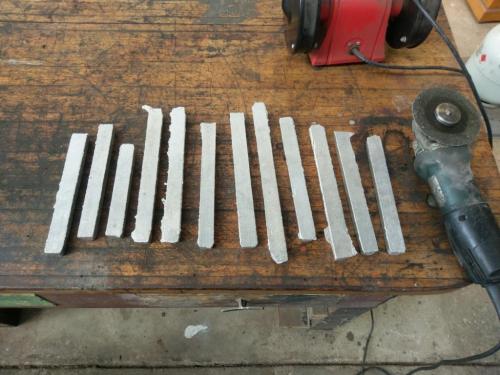
put one nice flat edge on each bar then flipped them over and milled the opposite side so I had consistent thickness
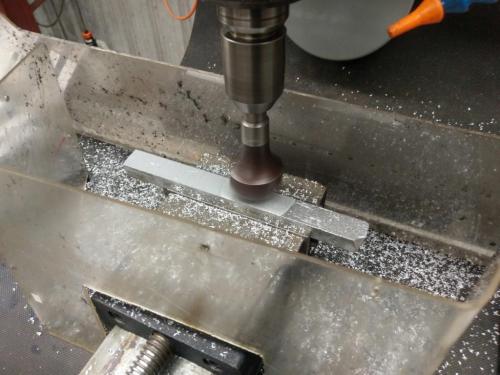
then cut it all up into little pieces, mounted in the mill vice in pairs so I could pilot-drill and bore on the join line
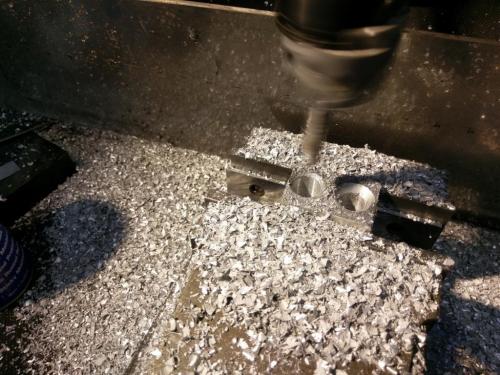
ended up with five 1/2" and eighteen 3/8 double hose brackets.
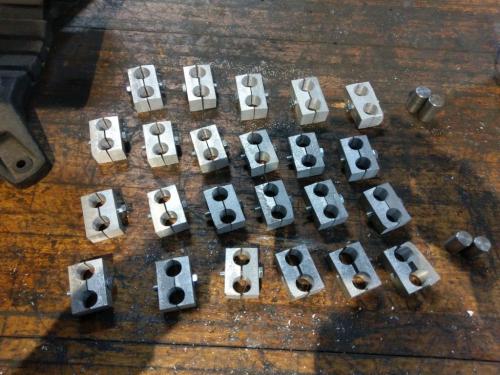
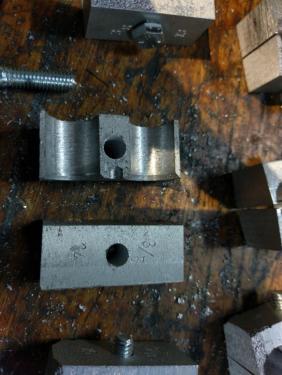
the photos remind me I still have to chamfer the back end of the bores. Don't want them to cut into the hoses.
Having the curl rams in place allowed me to start figuring out the parallel linkage arrangement, lots of plywood mockups and eventually I decided I need to be able to lift the loader to full height to ensure the angles allow it to empty a bucket at full height. The idea of the parallel linkage is to increase the total rotation, the old single linkage only rotated the bucket through about 160 degrees or so, which meant it was not curled back enough to keep stuff in when down low, and would not empty dirt without a vigorous shake when up high. It will now rotate through about 210 degrees, so curls fully back at ground level and tips almost upside down at full height. Anyway I needed to get the new 3-spool valve mounted and get the hydraulic hoses fitted up so I can lift and curl to confirm everything before I start cutting steel for the linkages.
I temporarily mounted the loader back onto the tractor to ensure I got the new control valve mounted in a nice ergonomic position- will get a photo of that- then I got a mobile hydraulic hose guy out to make up all the hoses. His portable crimping machine was a nice bit of kit. His invoice was just over double what I expected


I got prices for all the hose brackets that I need to keep everything tidy, was planning to use the usual poly block type gizmos but after spending up on the hoses I thought I'd save some cash and make my own brackets in aluminium.
I sacrificed another old mag wheel and cast some bar stock
put one nice flat edge on each bar then flipped them over and milled the opposite side so I had consistent thickness
then cut it all up into little pieces, mounted in the mill vice in pairs so I could pilot-drill and bore on the join line
ended up with five 1/2" and eighteen 3/8 double hose brackets.
the photos remind me I still have to chamfer the back end of the bores. Don't want them to cut into the hoses.
Lathe (n); a machine tool used in the production of milling machine components.
Milling Machine (n); a machine tool used in the production of lathe components.
Milling Machine (n); a machine tool used in the production of lathe components.




